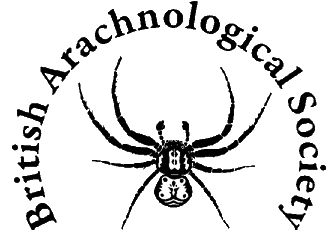Four-spotted Orbweb Spider Araneus quadratus
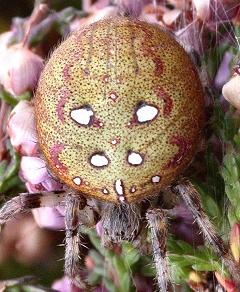
Araneus quadratus Clerck, 1757
Etymology: Araneus - Latin for spider; quadratus - Latin for square, referring to the four prominent spots on the abdomen. (It appears that no-one's quite sure what Epeira is derived from.)
General: Our heaviest spider, A. quadratus is an autumn-maturing orb-web weaver. Easily recognized; indeed it is one of Clerck's original species.
Description: Araneus quadratus is readily identified in the field by the four white spots on the abdomen even though the background can be quite variable in colour ranging from orange-red to light yellow-green. This coloration can change, perhaps responding to humidity levels (greenish if moist, tending towards red if drier). Behind the four spots, the wavy lines delineating the edge of the folium converge towards the spinnerets. Well-fed specimens lack the "shoulders" to the front of the abdomen, noticeable in others of the genus. The legs are annulated and the carapace bears a wide median band.
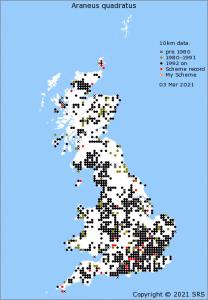
Distribution and habitat: A. quadratus is a widespread and relatively common spider in the UK but with a patchy distribution. It can be found in habitats which have vegetation of sufficient height and strength to support its large orb web which can have a diameter of up to 40cm (Jones, 1989[1]) with about 20 radii. The web is usually slung between adjacent plants with a tent-like silk retreat at one side in which the spider hides when not sitting in the centre of the web, a contrast with its congener A. diadematus which doesn't build such a retreat. Though large the web is rarely found over 1.5m above ground. Hence found in undisturbed, rank grass, heather, gorse in habitats ranging from downland to heaths, perhaps with a preference for the damper regions of such habitats.
Life Cycle: The spider matures in one season, with mating occurring in late summer to early autumn. The cocoon is then made and spiderlings hatch or leave the cocoon in spring. Crome (1956[2]) gave a detailed account of egg-laying and cocoon building (summarised by Foelix (1982[3]).
Eat ... and be eaten?
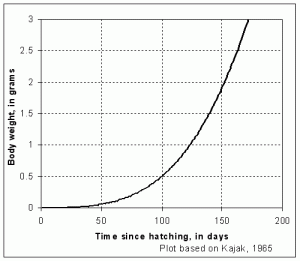
Bristowe (1958[4]) noted that it was "...certainly our heaviest as well as one of our most handsome spiders". Indeed Parker reported the find of an impressive A. quadratus which weighed in at 2.25 grams, on a field week at Juniper Hall in 1979 (Jones, 1980[5]). Elsewhere its size is also remarked upon, as is its egg-laying capabilities. Bristowe claimed a "record in child birth" for quadratus, having noted that a "...large specimen will lay more than 900 eggs which weigh twice as much as she does after the operation is completed". This is confirmed by Wunderlich (Sauer and Wunderlich, 1985[6]), who reports a gravid female, initially weighing 1.1 grams, reducing to just 0.3 grams after laying!
Given its size and the fact that the spider reaches maturity in one season, A. quadratus must have a healthy appetite. Perhaps because of this, but more probably because its relatively common, A. quadratus has been used in several feeding experiments on spiders. Anna Kajak (1965[7]) studied the spider, together with several other species, over a period of years. In a paper comparing "consumption" rates in various species, she concluded that A. quadratus does indeed show a high rate of feeding and growth, with one of the highest rates of increase per unit of body mass, with the larger individuals putting on up to 10mg (dry weight) per day. Not only that, but perversely, its apparent burst of weight gain occurred in September when insect numbers were in decline. Kajak gave an expression relating mass of prey consumed to the spider's body weight. Taking a slight liberty with the equation one can produce a growth plot for the spider (see figure). This assumes an initial weight of 0.1mg (for a ~1mm diameter egg, a reasonable egg size! (Livecchi, Le Berre and Ramousse (1977[8])) and makes various other approximations, such as 1mg of dry weight of prey being converted to 1mg fresh weight of spider. The resulting plot shows that it is quite reasonable for a well-fed A. quadratus to attain a mass of 2.5gm in a single season.
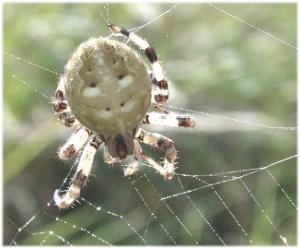
Nyffeler and Benz (1978[9]), found that bees were a major component (by mass) of the diet of A. quadratus. However, this may have been more to do with prey availability, as, in a later study (1989[10]) diptera, homoptera and aphids were the major prey. This agrees with the earlier work of Kajak. She showed that, at her study sites, diptera made up a greater proportion of the diet. In fact the number of bees caught in Nyffeler and Benz's 1978 study were low but their large size contributed disproportionately to biomass caught. Nevertheless, their results confirm that A. quadratus can cope with such powerful and potentially dangerous prey.
Robinson (1975[11][12]) reported that the members of the Araneus genus have a preferred method of dealing with prey. A trapped prey item is first given an initial silk wrapping at the site of capture before being bitten; it is then cut out of the web and carried to the web's centre where it is further wrapped. It may then be fed upon or stored in the web for later consumption. Of course, the spider's behaviour is not totally rigid. For example, if the prey is small enough, the initial wrap and bite may be dispensed with and the prey carried directly to the centre of the web for wrapping and consumption. Or, if a second prey item is caught in the web whilst the spider is already dealing with a first, then the second may be "stored" at the site of capture, to await later consumption. This prior wrapping is not just a whim on the spider's part, but, as Eisner and co-workers have shown (described in a very readable way by Eisner[13]), it has a very reasonable purpose in that powerful or otherwise dangerous prey do not have to be approached too closely and are made manageable when shrouded in silk. The silk is ingested with the prey and is actually quite rapidly re-cycled[14].
As with other members of the genus, A. quadratus macerates its prey, rather than merely injecting digestive juices, sucking out the resulting "soup" and leaving an empty husk. The cheliceral teeth sported by the araneids must help in this process (conversely, those groups which leave an empty husk after consuming their prey often have relatively small cheliceral teeth (e.g, Theridiidae and Thomisidae)[15].
Turning the tables slightly, Bristowe included A. quadratus in his tasting experiment one afternoon when he was staying at Flatford Mill[16]. He doesn't mention why A. quadratus was chosen for his gastronomic adventure but he does note that, of the spiders tasted that day, "... Araneus quadratus, with a slightly nutty flavour, was the best".
References
- ↑ Jones, D. 1989. A Guide to Spiders of Britain and Northern Europe. Hamlyn, London
- ↑ Crome, W. 1956: Kokonbau and Eiablage einiger Kreuzspinnenarten des Genus Araneus. Dtsch. Ent. Z. (N.F.) 3 28-55
- ↑ Foelix, R. 1982: Biology of Spiders. Harvard University Press, Cambridge, Mass. p. 200
- ↑ Bristowe, W. S. 1958: The World of Spiders. Collins, London
- ↑ Jones, D. 1980, The spider course at Juniper Hall field centre, Box Hill September 1979. Newsletter of the British Arachnological Society 27, 13
- ↑ Sauer, F. and Wunderlich, J. 1985, Die schönsten Spinnen Europas
- ↑ Kajak, A. 1965: An analysis of food relations between spiders - Araneus cornutus Cl. and Araneus quadratus Cl. - and their prey in meadows. Ekol. pol. A13: 717-764.
- ↑ Livecchi, G. Le Berre, M. and Ramousse, R. 1977: Interaction ponte construction et developpement du cocon chez Araneus diadematus. Revue Arachnologique. 1(2), 45-57
- ↑ Nyffeler, M. and Benz, G. 1978: Die Beutespektren der Netzspinnen Argiope bruennichi( Scop.), A. quadratus Cl. und Agelena labyrinthica (Cl.) in Odlandwiesen bei Zürich. Revue suisse Zool. 85: 747-757.
- ↑ Nyffeler, M. and Benz, G. 1989:Foraging ecology and predatory importance of a guild of orb-weaving spiders in a grassland habitat. J. App. Ent. 107 166-184.
- ↑ Robinson, M. H. 1975: The evolution of predatory behaviour in araneid spiders. in Function and Evolution in Behaviour ed. Baerends, Beer and Manning, Clarendon Press, Oxford
- ↑ Foelix, R. 1982: Biology of Spiders. Harvard University Press, Cambridge, Mass. p. 165
- ↑ Eisner, T. 2003: For Love of Insects. Harvard University Press, Cambridge, Mass.
- ↑ Foelix, R. 1982: Biology of Spiders. Harvard University Press, Cambridge, Mass. p. 110
- ↑ Foelix, R. 1982: Biology of Spiders. Harvard University Press, Cambridge, Mass. p. 42
- ↑ Bristowe, W. S., 1958: The World of Spiders. Collins, London p. 246
Links to other sites with info on, or images of, Araneus quadratus
- Spider Recording Scheme with up to date distribution information
- Jorgen Lissner's pages: http://jorgenlissner.dk/Araneidae.aspx
- Czech spiders: http://www.pavouci-cz.eu/Pavouci.php?str=Araneus_quadratus
- Ed Nieuwenhuys' pages: http://www.xs4all.nl/~ednieuw/Spiders/Araneidae/Araneidae.htm
- Encyclopedia of Life
- Wikipedia
